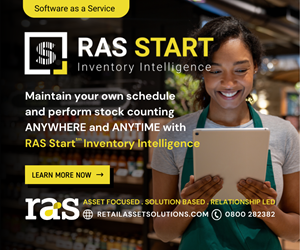industry focus
Investing in Research - Keeping it Fresh
By Colin Peacock, ECR Community
Someone recently asked why the ECR Community Shrink & OSA Group has kept going for so long. There are numerous explanations, not least the generosity of its members in hosting meetings and sharing data, but the main driver is that the group has consistently delivered new research insights and practical tools to help its members improve their own operations and produce better results. For example, one European member retailer reported it had leveraged the Fresh Case Cover metric tool (developed from the ECR research with the University of Eindhoven) to inspire food waste savings of over 1 million.
To set its research agenda, the group has, since its inception, regularly reflected on current and emerging challenges facing its members and their organisations and agreed on key questions that new academic research could answer to meet those challenges.
A typical ECR-funded research project usually has two main objectives:
The first is to provide data concerning the nature and scale of a given problem or challenge, to what extent is it happening, how much is it costing, why it is happening, and so forth. This information helps members acquire new data points that they can then use within their organisations to inspire and/or benchmark their own performance. For example, one retailer used the data from the employee engagement study to calculate the financial benefits of improved store associate engagement.
The second broad objective for ECR research projects is to document best practice and create a road map or checklist that organisations can use to put the research in action. For example, a recent study provided sixty-five best practices to sell more and waste less.
For 2017, our research agenda is busier than in any previous year, with five research projects underway on the topics of inventory accuracy, self-scan, collaboration on food waste reduction, RFID, and click-and-collect returns. They are supported by academics from universities across Europe, including the EM-LYON Business School (France), the Cardiff Business School (UK), Technische Universitt Darmstadt (Germany), Eindhoven University of Technology (Netherlands), Kuhne Logistics University (Germany), the University of Portsmouth (UK), and the University of Leicester (UK).
Following is a quick overview of each of these five research projects.
Inventory Accuracy
Does more accurate inventory grow sales? If so, by how much, and what investment is required to improve it?
With billions invested in replenishment and forecasting systems, which are reliant on inventory records, it would seem almost a rude question to ask whether accuracy matters. Yet with some published evidence suggesting that as much as 65 per cent of inventory records are wrong, there seems to be little evidence of major change projects on inventory accuracy amongst group members.
This is perhaps even more surprising given the growing importance of online sales, where shoppers will want to know with certainty that the item is in stock before they order or travel to a store. One hypothesis, proposed in Inventory Record Inaccuracy in Retail Supply Chains by Nicole DeHoratius published in the Wiley Encyclopedia of Operations Research and Management Science (2012), could be that retailers already know that most inventory record errors do not negatively impact sales as the inventory record error does not necessarily mean that the shelf is empty. And even if it is, there may be a presumption that the shopper will simply switch to buy another product.
However, this may not be the case. Group discussions suggest that when inventory records are "trued up", the store and/or high shrink categories can see up to a 3 to 6 per cent lift in sales. This is a similar uplift in sales being reported by apparel retailers that are attaching RFID tags to their products, where the main benefit of the system is to improve inventory record accuracy.
The research will be undertaken by academics with deep expertise in this field from three academic institutions - Cardiff Business School, EM-LYON Business School, and the Technische Universit Darmstadt. Their first research objective will be to establish, and turn into a credible and inarguable number, the impact on sales when inventory records go from being inaccurate to accurate. The aim is also to understand how the impact on sales varies by store format and by category. The second phase will be to establish the current best practices retailers are using for inventory record accuracy improvements and to identify the emerging techniques and technologies that could be used. The results from the first phase of the research will be shared with the members of the ECR Community Shrink & OSA Group in February 2018.
Self-Scan Systems
What is the measurable impact of these systems on levels of retail loss? What are the main drivers of self-scan related losses (such as malicious and non-malicious causes)? And what strategies and interventions are being used to mitigate these losses?
When asking shoppers to take responsibility for both scanning and paying for items they wish to purchase, using either a mobile device (provided by themselves or the store) or at a self-scan checkout, the well-worn phrase "what can possibly go wrong?" springs to mind. About ten years ago when the latest round of self-scan systems were being piloted, seemingly the answer was "very little". Early adopters found that store productivity was considerably improved (fewer staff hours required) with no evidence of an increase in shrinkage that could be directly attributable to self-scan. Indeed, one supermarket retailer, Big Y in the US, reported that customers' error rates were lower than its cashiers. Moreover, the perception of customer service was thought to have improved as customer interactions grew with self-scan systems.
Fast forward to 2017. The use of self-scan systems has not only grown dramatically, but also changed profoundly. Today, what is meant by self-scan has expanded to include scanning and paying using a smart phone. There are now stores where you can only pay by self-scan methods. The supervisor to self-scan checkout ratio has grown from one to four to, in some cases, one supervisor to more than twelve checkouts. Finally, with now millions of shoppers using self-scan every day and awareness that a simple mistake such as not scanning an item is rarely detected, the temptation and the scale of risk is growing considerably.
The aim of the research, being undertaken by Professor Adrian Beck at the University of Leicester, is to understand, from data gathered from around ten participating retailers, the scale and nature of the increased risk associated with various self-scan systems and to identify the best practices being developed to try and manage the problem more effectively. Professor Beck expects the results from this study to be shared with the members of the ECR Community Shrink & OSA Group in February 2018.
Collaboration
What does it take for collaboration to be sustained, and how can retail organisations get started?
With one-third of food made for human consumption being wasted, everything points to the need for all actors to proactively reduce food waste. There is much each actor can do within their own four walls. However, many believe collaboration across the entire supply chain will deliver the biggest impact. Collaboration is easier said than done. Some barriers include a lack of evidence that collaboration works, competing incentives across silos and organisations, a lack of trust between buyers and sellers, a lack of data on where waste occurs across the entire supply chain, and insufficient capacity to invest time in collaborative projects. Currently, each organisation shapes its own response to the opportunity to collaborate and how they work together based on its own business context, values, and priorities. By way of example, earlier this year, due to an unseasonably warm winter, UK farmers had a bumper crop of cauliflowers that far exceeded the quantities ordered by their retailer buyers. Traditionally, farmers would be faced with the prospect of having to throw away large quantities of perfectly edible but surplus to requirements cauliflowers.
However, judging by the press coverage at the time, there were two UK retailers who very publicly declared their intention to work with their suppliers to increase demand (through lower prices, bigger displays, the promotion of cauliflower-based recipes, and so forth) so that excess supply could be sold and consumed and hence fewer cauliflowers would be wasted. Based on the response from these two retailers, it was clear that they understood the value of working together with their supplier partners and the benefits of reducing food waste. What this research intends to discover is what it takes to be great at collaboration, with food waste being the initial focus.
This piece of research will have academic support from Cardiff Business School and Kuhne Logistics University, in partnership with the global food waste practice leaders at Oliver Wyman. The deliverables will be a maturity model that will unbundle the dimensions and aspects that need to be in place for great collaboration to happen, evidencing them with real-world examples of each dimension and any benefits that can be attributed to their adoption. In addition, a simple collaborative assessment tool will be created that will allow retailers and manufacturers to self-assess their current collaboration states. The final report and self-assessment tool will be shared with the members of the ECR Community Shrink & OSA Group in February 2018.
RFID
How do you make RFID pay?
At the "peak of inflated expectations", RFID was going to revolutionise the shopping journey, no more boring time spent standing in a queue waiting for the items to be unloaded onto a checkout conveyor belt, scanned, and then put back into your trolley. Shoppers would simply walk out of the store with all the items scanned automatically by an electronic reader as they exited, and their receipts would be sent by email. Easy peasy.
Then the reality of physics, privacy, and cost sharing, to name but three hurdles, slowed the early momentum and triggered the start of the "trough of disillusionment", and the early advocates started pulling back their investments. However, as sure as night follows day, the "slope of enlightenment" followed, and the most RFID-advantaged retail sectors began to cautiously embrace the technology. This research, led by Professor Adrian Beck with the support of GS1, will aim to examine how eight retailers have deployed RFID in their organisations.
The research will chart the way in which the technology was introduced, the business cases that were developed, the perceived benefits and limitations of the systems used, and how their performance was measured. The final report and the practical deliverables will be shared with the members of the ECR Community Shrink & OSA Group in May 2018.
Omni-channel Returns
What is the true cost of a return?
There are few retail sectors, if any, not impacted by the growth of online shopping. And this growth is showing no sign of slowing down. A key question for every retailer paying high rents and rates for brick-and-mortar estates is to consider to what extent these stores are either assets or liabilities. One answer can be to see these stores as assets and a means by which they can fulfil their customers' online orders faster, cheaper, and easier. To this end, many retailers are now offering a click-and-collect service, using retail stores as a point at which the consumer can pick up their items ordered online.
By way of example, a European department store, part of a retail organisation with many formats and stores, offers its shoppers the option to order an iPad, a suit, a pair of shoes, and more online and collect it at any one of the company's many stores with no delivery charges. For their online business and customers, this is a far more efficient, convenient, and budget-conscious way to get what they want. For the stores fulfilling the department store's online orders, the hope is that when the customers collect their orders, they will come into the store and buy other items. For the marketing teams, this looks like a winning proposition. However, through the lens of those who run the stores and the loss prevention team, the list of risks and concerns is extensive:
- How do I protect the items ordered online and sent to the store for collection from any vulnerability to theft and fraud?
- How do I send goods not collected or returned to the store back to the distribution centre?
- How do I know that these returns are not fraudulent and the goods are not fake?
- Who will train my team? How much time will this new process incur? Will I get more hours?
These challenges are significant and meaningful. One ECR group member shared that for these reasons they shut down one of their click-and-collect operations.
The aim of this study, led by Professor Lisa Jack, Regina Frei, PhD, and Sally-Ann Krzyzaniak at the University of Portsmouth, is to learn from retailers (via site visits, interviews, and surveys) the extent of the risks and concerns relating to click-and-collect returns, the true cost of those returns, and the best practices and controls that can reduce the cost. The final report and best practice guides will be shared with the members of the ECR Community Shrink & OSA Group in February 2018.
Getting Involved
If any of these research projects are of interest to your organisation and you would like to contribute to the research, get connected to the ECR Group. However, if you just want to be one of the first to read the conclusions and start to use the tools, then make sure to bookmark the group's website at ecr-shrink-group.com and plan to attend one of the future meetings where the academics will present their findings.
Finally, as with all the articles in the ECR series, the aim has been to stimulate new thinking and ideas. One way you could do this would be to add these topics to your next team meeting agenda.






